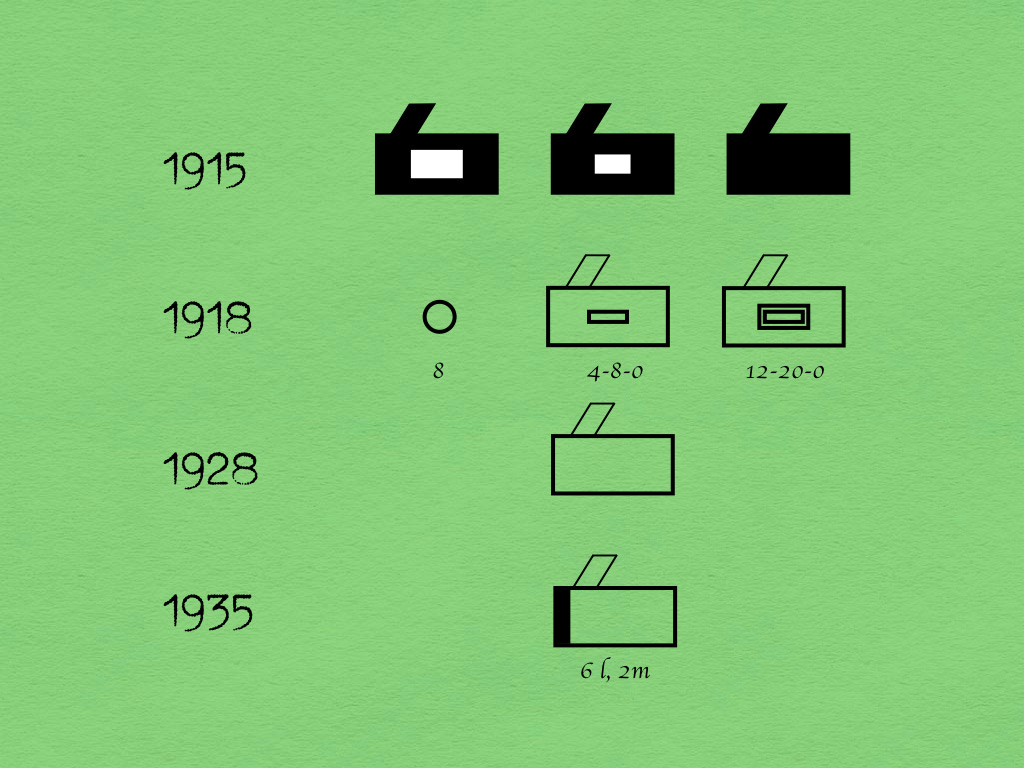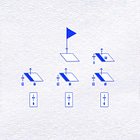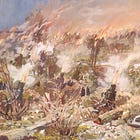Depicting Minenwerfer

The trench mortar made its debut in 1914, a time when, thanks a proliferation of new weapons and types of units, the standardization of tactical symbols lagged far behind the creation of such hieroglyphs. Nonetheless, while there were many variations on the basic theme, most symbols used in the armies of the German Empire to depict their Minenwerfer (“mine throwers”) bore a close resemblance to each other. That is, each consisted of a rectangle surmounted by an angled parallelogram. (The former, it seems, represented the substantial base of the weapon while the latter stood for the barrel.)
In 1915, when German trench mortars were frequently fielded as independent detachments of six, four, or even two weapons, one draughtsman used white rectangles to indicate the size of the Minenwerfer in each unit.1 If the white rectangle was large, then the weapons in question were light (75.8mm) Minenwerfer. If the white rectangle was small, the weapons in question were medium (170mm) Minenwerfer. If, however, there was no white rectangle at all, the trench mortars were heavy (250mm) Minenwerfer. (The words above each symbol indicate the name of the depicted detachment.2 The numbers below show the number of weapons in each unit.)
By 1918, Minenwerfer had been formed into companies, some of which had been assembled into battalions. At the same time, light Minenwerfer, which had come to outnumber trench mortars of larger sorts, found new homes in infantry regiments, Jäger battalions, and assault battalions.
To represent this reality within a reinforced infantry division, the creator of one organizational infographic used simple circles to depict the detachments of light Minenwerfer assigned to infantry units. At the same time, he used variations on the basic Minenwerfer symbol to indicate the presence of companies and battalions armed with medium and heavy trench mortars. (The symbol for a Minenwerfer company bore an additional rectangle within its base. The symbol for a Minenwerfer battalion featured two extra rectangles.)
The creator of these symbols used numerals to indicate the number of Minenwerfer of each type assigned to each unit. In the case of the infantry trench mortar detachments, which were equipped exclusively with light Minenwerfer, a single numeral sufficed.3 In the case of the larger units, a series of three numerals indicated the number of heavy, medium, and light Minenwerfer on hand. (Marvelous to say, this convention survived the transfer of the light Minenwerfer to infantry units, resulting in one of the few instances in which the numeral zero appeared in a German tactical symbol.)4
In the interwar period, the basic symbol for Minenwerfer was often used to represent the 13th (Trench Mortar) Company of each infantry regiment. At times, however, the hieroglyph for this type of unit bore the dark bar of an infantry heavy weapons company.
In the example on the bottom row of the green diagram, the symbol for a Minenwerfer company was also provided with an indication of the number and type of weapons assigned. As the draughtsman departed from the convention of listing the heavier weapon before its lighter counterparts, he felt obliged to mark one numeral with an “l” (for leichte) and the other with an “m” (for mittlere.)5
These symbols appear in the organizational chart appended to Ernst Schmitt, Argonnen (Schlachten des Weltkrieges, Band 18) (Oldenburg i. O: G. Stalling, 1927.)
The names of the trench mortar detachments translate to Heavy Trench Mortar Detachment 8, Medium Trench Mortar Detachment 138, Light Trench Mortar Detachment 205.
These symbols appear in the organizational chart included with 213. Infanterie Division Abtlg. Ia No. 139/v geh. dated 16 May 1918, BA/MA PH 8 I/56.
The characters below the numerals indicating the number of trench mortars of each type in the unit indicate the parent division of the Minenwerfer company. These are the 80th Reserve Division, the 203rd Infantry Division, and the 19th Reserve Division.)
This symbol appears in the organizational chart for the I. Armee Korps (Königsberg) in Gliederung der Truppen des Heeres ab 15.10.1935, German Docs in Russia.









